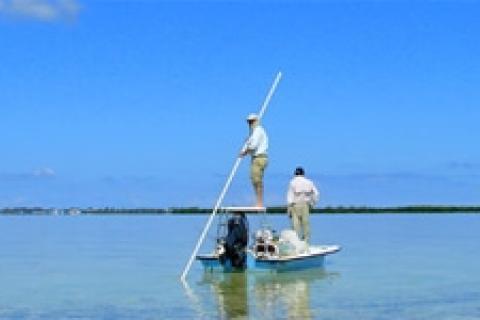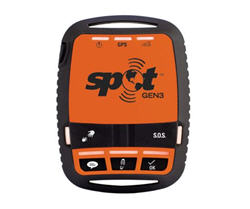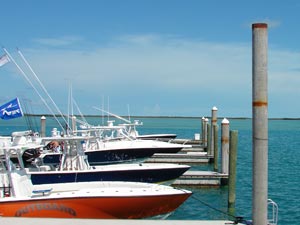
Bimini, a chain of islands located in the westernmost district of the Bahamas, lies only 48 nautical miles east of Miami, Florida. For U.S. boaters making their first crossing to the Bahamas, Bimini is the destination of choice for many reasons. For one, the Bahamas are one of the most "boating-friendly" of America's adjacent subtropical neighbors. If you've not been there before, you're in for a splendorous treat. The cruising, fishing and exploring opportunities are endless in this island nation, and the water is so clear, it seems your vessel is gliding through air.

Besides the benefit of proximity to the U.S., Bimini has an exceptional marlin, bonefish, wahoo and bluefin tuna fishery that has lured angling giants such as Ernest Hemingway and Michael Lerner to its deep waters, and to its flats, professional athletes such as Jack Nicklaus.
For those making the trip across the Gulf Stream who don't like to fish, there are plenty of other exciting activities. The snorkeling, diving, fish stands, straw market, Ansil Saunder's boat factory and Ashley Saunder's Dolphin House provide days of entertainment.
For the more mythically minded, a dive over the Bimini Roads will reveal what some believe are the remains of Atlantis. Perhaps a trip and dip to the Healing Hole is in order — Ponce de Leon is reputed to have visited this very same spot in the search for the Fountain of Youth.
Clearly, Bimini offers great fun for everyone. Yet one of this island's most vessel-relevant happenings is of utmost relevance to U.S. boaters: this is the development of Bimini Bay Resort and Marina. This ambitious complex offers beautiful housings that can be rented for vacation or purchased, an infinity pool and snack bar, and the gourmet Casa Lyon restaurant. They have completed the building of the first part of two of the largest full-service marinas in the Bahamas. Because of Bimini Bay Resort and Marina, Bimini just got better in the biggest way for traveling boaters.
Watching the Bimini Weather
Generally speaking, summertime is the calmest time of the year for you to make the crossing over to Bimini and the Bahamas. The one caveat, though, is anticipating and "scanning" for the development of the sometimes fiercely potent afternoon thunderstorms that build up over the Florida mainland and proceed seaward.
Since the Gulf Stream flows northward along the Miami to Bimini route, any day with substantial winds out of any northerly quadrant should be ruled out as a "crossing day." These conditions often involve the cold fronts of fall, winter and spring that can heap up offshore seas to dangerous heights. During South Florida's "season," be sure to pick a "weather window" when the seas are either quite calm or feature light winds out of a southerly or southeasterly direction.
The Bimini Crossing

productive flats in the world.
Although 48 miles from the U.S. to an exotic foreign port seems a short distance, comprehensive planning and boat preparation are essential. In large part this is because you'll be crossing the mighty Gulf Stream: this mighty river in the Atlantic Ocean has a current that flows at two-and-a-half knots minimum and sports depths of thousands of feet. Depending on weather conditions, the Gulf Stream can range from a flat calm sapphire-colored expanse to a towering sea of white and sapphire rolling and breaking with 15-feet high waves.
The general guidelines and goals you'll want to accomplish includes everything from float plans, flotilla organizing, boat and engine checks and preparation, accessory (redundancy) acquisitions like prop hubs and spark plugs, full safety equipment status, and of course, a solid "weather window" check.

Personal Tracker
It's easy to file a float plan with the proper parties so that, for safety reasons, the day of your departure and estimated arrival is known to someone other than yourself. You can also acquire a SPOT GPS Personal Tracker to keep land-based family apprised of your crossing progress on Google maps. Given the proper time and affiliations, it's also relatively easy to contact other boaters and carve out the time for a Bimini trip and cross over together. Creating a flotilla enriches the maxim that there is not only strength, but also safety, in numbers.
You'll want to carefully and thoroughly go over every working part of your vessel and its propulsion system. Use your "crisis management" imagination and think about any part that might fail: buy an exact replacement for your crossing when it is practical to do so. Using the concept of redundancy to govern your spare parts choices creates a thorough back-up capacity for you in case failure strikes while you're on the high seas and far from port. For instance, bilge pump integrity is essential, as well as the fully charged battery that powers it.
As an experienced boater, you've checked and obtained the required safety equipment you are to have onboard your vessel. Amongst those items are life jackets and fire extinguisher(s) that should be checked and in good "fresh" working order. Make sure you have lots of and only SOLAS (Safety of Life at Sea) flares. For better peace of mind, spend the money on a fully equipped inflatable life raft and emergency kit. You'll also want to complete this category of safety equipment with a high quality EPIRB.

The pace of development in electronics, digital applications, and interface with space age relays is proceeding at a lightning pace. This is certainly the case in boating navigation, as well as all the informational data — such as weather — that apply to it. It is certain that this technology will become faster, smaller, more-information rich "per pixel" and vastly more user-friendly.
This data is now trending off the flying bridges and center consoles of vessels into personal smartphones and ipads. Statements about current state-of-the-art electronics can become obsolete within months, but we can be sure all these developments will greatly assist boaters in terms of streaming huge amounts of essential information.
Life in the age of technology has simplified navigation for big-water boaters. The basics involve acquiring a GPS/Chartplotter with a worldwide basemap as part of your navigation electronics. For safety sake, back your unit up with a hand-held GPS. Since you won't want the electronic revolution to deprive you of needed seamanship skills, you should have the implements and training to dead reckon across the Gulf Stream: this traditional methodology transcends electronics. These skills include coordinating your course with compass heading and the speed of the Gulf Stream's current. Obviously, a go-fast center console fishing boat will have lesser adjustments than a sailboat.
Your communication electronics should include a good waterproof mounted VHF radio with a high antenna. It would be better yet if you purchased and installed an SSB radio. Consult an expert technician for joining your radio with the onboard GPS system for signal location attainment. You'll attain the fullest peace of mind in your communications arsenal by adding a handheld VHF radio as well as a satellite telephone, the latter of which can be rented. Be sure to get waterproof casings for your handheld items.
Your Bimini Destination
If you arrive during daylight hours, you'll get the first hint of real-time landfall by the presence of boats trolling offshore of Bimini. If it's dark, be on the lookout for the tower with red lights. Even though your GPS is there to hold your hand and confirm your position, learn to use your eyes to identify the images that verify your arrival; it's been done since time immemorial and it's more fun.
Ease through the Bimini Inlet and proceed to clear Bahamian Customs and Immigration. Since you've done your homework and arranged dockage, cruise over, tie off, and snuggle up to some welcome land. In your planning, it's a safe bet to make your arrangements with Bimini Bay Resort and Marina — because of its huge size and unmatched services and amenities, this is the preeminent place for you and your vessel.
All that done, put on more sunblock and throw on a swimsuit...or perhaps it's fishing clothes for the flats or bluewater...or maybe shorts and a sport shirt for a walk around Alice Town. Have a cool tropical drink and get into the island groove — no worries, mon! You arrived safely and successfully. Enjoy yourself now — you've earned it!
- 114209 views

